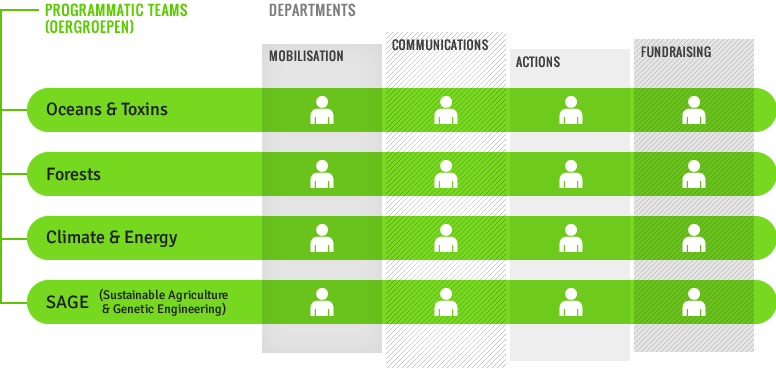How does it work?
While many GP offices have experimented with creating cross-departmental teams to tackle specific projects, GP Netherlands’ approach has a different nuance. Each team is semi-permanent — that is, it stays in existence over an extended period of time in order to establish continuity, open lines of communication, ensure long-term buy-in and expertise, and ensure the ability to respond more quickly when opportunities arise.
Each staff member at GP Netherlands still belongs to a specific department. But they may also belong to one of these Oergroepen. (This is an example of matrix management.)

Each Oergroep meets on a regular basis, and even develops their own annual goals and objectives. When working with the members of their Oergroep, each department brings the perspective of its unique expertise. Here’s an example scenario, from the Netherlands team:
- The Actions department might propose working with volunteers to run a nighttime observation on a local logging operation.
- Mobilisation might realize that presents a great opportunity to engage people interested in protecting forests, and suggest the volunteers record a video after the operation.
- Communications might suggest it’s a great hook for a local story, and prepare to reach out to environment-focused reporters.
- The detox campaign comes up with the strategy to focus on fast fashion.
- The comms department thinks that focusing on young women as the target audience will be most affective.
- Mobilisation might realize that presents a great opportunity to give engaged volunteers with interests in fashion a role in reaching out and mobilising other people in their own fashion-minded networks.
- Communications/ Media might suggest these fashionistas create a great hook for personal stories and prepare to reach out to fashion-focused reporters/media.
- Actions might think about opportunities for taking action against one of the target companies with all the fashionistas to help build pressure.
Challenges
The Oergroepen encourage integration and creativity, but they’re also a work in progress. Greenpeace Netherlands notes some challenges they’re trying to figure out:
- Managing expectations. Putting people into these cross-functional groups on a regular basis generates a surplus of ideas, creativity and excitement around potential campaign ideas. However those ideas sometimes outpace the capacity to execute on them. How can the team best balance creativity with realistic expectations? One adjustment under discussion is simply for the Oergroepen to meet a bit less frequently, in order to better balance the creative idea generation stage with execution capacity.
“The most interesting problem is that people in Greenpeace are so driven and so focused on winning campaigns that these programmatic groups come up with huge plans. It creates work for way more people than we have staff. At some point you have to tune down the ambitions even though you don’t want to.”
– Meike Baretta, Director of Actions & Outreach
- Group vs. Department goals. Many departments have specific overall targets for the year. However they have to figure out how to split those goals between the various campaigns happening in each Oergroep, none of which are completely within their department’s control. That is complicated, and highlights a common side-effect to greater cross-departmental collaboration. By moving to a more collaborative model each department necessarily gives up some control, and has to depend partly on others to hit their targets.
- Orchestrating the symphony. The Oergroepen create great integration within a given theme, but GP Netherlands is still trying to figure out how best to coordinate across these groups, and how to establish clear rules around who is responsible for making key decisions, and who leads on big picture strategy. In addition, structural questions are yet to be worked out in order to ensure consistency in the success of Oergroepen across the NRO.
What’s the impact?
Though there are certainly still questions that need to be answered, the Netherlands’ experimental teams model has one key advantage over other cross-department teams that only exist for the duration of one specific project: continuity.
In the past, when a new project started up, the project lead had to assemble the team, which takes time and risks missing the window of opportunity. Now, there is a team ready to get started immediately, which is key to effective mobilisation.
“We used to work with project teams. So we’d think of which people would be part of a project, and then work on that for a set amount of time. Then we would all go back and wait until the next moment and start over again. But then you’d miss ongoing campaign opportunities that arise, and you’d have the old situation of the campaigner flagging, “Hey, I need someone now. Who can help me?”. Whereas if you’re part of the thinking and the strategy process as a team throughout the year, then it’s not limited to an abrupt decision to call on someone. You can anticipate what’s coming, and really work on campaigns in an integrated way.”
– Simone Langley, Coordinator Mobilisation Unit
In addition, when a campaign opportunity arises, the Oergroep already has experience working together, open lines of communication, and an existing structure within which to work. They have also spent time setting goals and objectives together, which let them evaluate the opportunities and merits of each campaign.